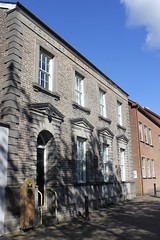Alfred Russel Wallace OM FRS


Alfred Russel Wallace OM FRS
(1823-1913)
Commemorated on 6 plaques
Alfred Russel Wallace 1823-1913 naturalist lived here
44 St Peter's Road Croydon, London, United Kingdom where they lived
Alfred Russel Wallace O.M. Naturalist 1823 - 1913 wrote The Malay Archipelago whilst staying in Treeps 1867-1868
Treeps, High Street, Hurstpierpoint, United Kingdom where they stayed (1867-1868) and wrote (1867-1868)
In this house lived Alfred Russel Wallace OM. LLD. DCL. FRS. FLS born 1823 - died 1913 naturalist author scientist educated at Hertford Grammer School
Wallace House, 11 St Andrews Street, Hertford, United Kingdom where they lived
Alfred Russell Wallace 1823-1913 Designed this building. He lived in Neath from 1841 to 1848 during which period he worked as a surveyor and studied natural history. In his lifetime he collaborated with Charles Darwin in the study of the law of natural selection, and with him presented the first paper on the subject in 1858.
4 Church Place, Neath, United Kingdom where they designed and lived near (1841-1848)
This museum was first opened to the public on June 21, 1849. The collection was originally formed by the Literary and Philosophical society, and by it presented to the town. Admission is free to visitors, whether residents or non-residents whenever the museum is open. Henry Walter Bates, F.R.S., 1825-1892 and Alfred Russel Wallace, F.R.S., 1823-1913 These two Victorian naturalists, friends of Charles Darwin, have strong associations this part of Leicester. Bates was born a hundred yards or so from the site of this museum, and met Wallace when the latter was teaching at the Collegiate School just off the London Road. In 1844-1846, the two joined forces in our expedition to the Amazon in 1849. Wallace returning in 1852 & Bates in 1859, the year in which Darwin's “Origin of Species” was published. In 1858 Wallace discovered, independently of Darwin, the principal of natural selection as a key factor in evolution. Bates on the Amazon, discovered over eight thousand new species of animals, mostly insects, and it gave the first explanation of what is now known as Batesian Mimicry.
New Walk, Leicester, United Kingdom where they was
Alfred Russel Wallace naturalist 1823-1913 built this house and lived here from 1872 to 1876
The Dell, 25 College Avenue, Thurrock, United Kingdom where they lived






